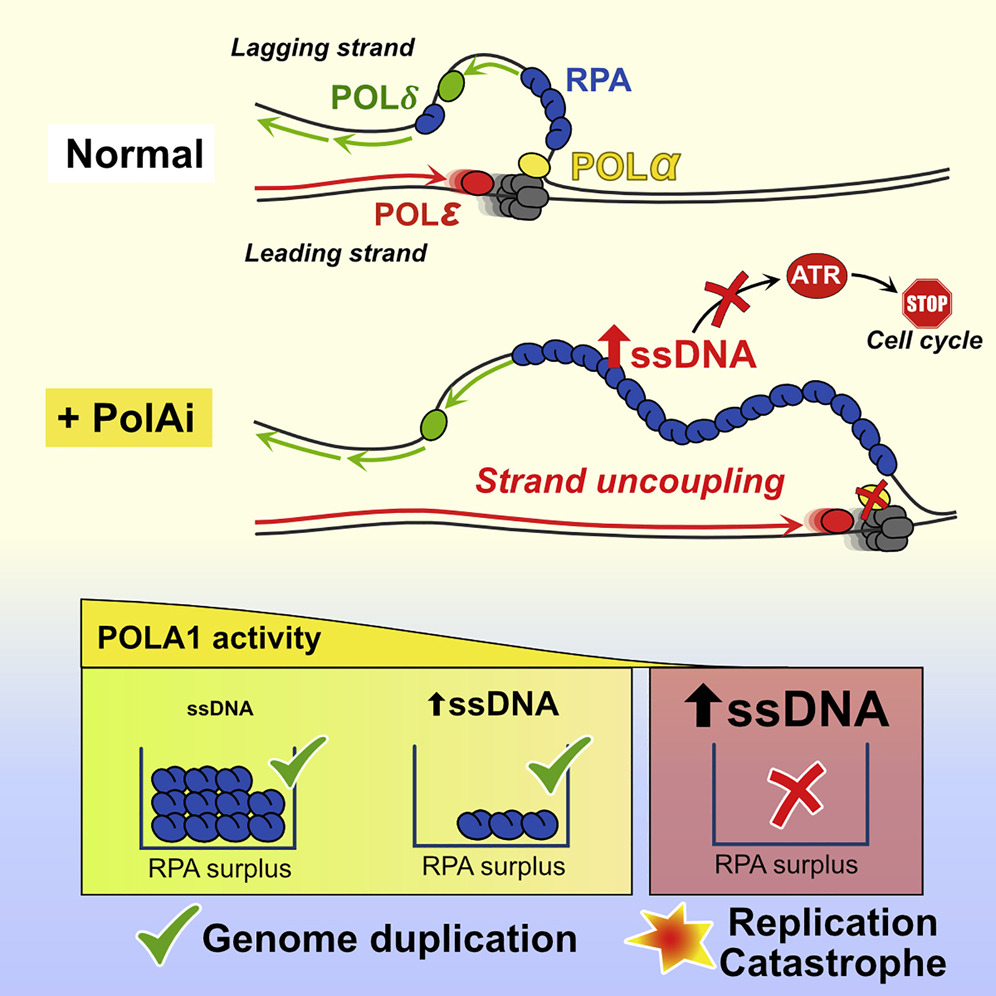博文
发现DNA可以导致新型癌症药物
|||
发现DNA可以导致新型癌症药物
诸平
据丹麦哥本哈根大学(University of Copenhagen)2020年2月28日提供的消息,该校健康与医学学院(Faculty of Health and Medical Sciences)的科学家最近研究结果表明,细胞可以在比以前想象的更大压力下生存和繁殖。这是通过抑制必需基因DNA聚合酶α(polymerase alpha, POLA1)发现的,POLA1在细胞分裂过程中会启动DNA复制。相关研究于2020年2月18日在《细胞报告》(Cell Reports)杂志上发表——Amaia Ercilla,Jan Benada,Sampath Amitash,Gijs Zonderland1,Giorgio Baldi,Kumar Somyajit, Fena Ochs, Vincenzo Costanzo, Jiri Lukas, Luis Toledo. Physiological Tolerance to ssDNA Enables Strand Uncoupling during DNA Replication, Cell Reports, 2020, Volume 30, Issue 7, 18 February 2020, Pages 2416-2429.e7. DOI: 10.1016/j.celrep.2020.01.067. https://doi.org/10.1016/j.celrep.2020.01.067
这一发现为研究人员提供了有关DNA复制的新见解,并有可能用于新型癌症治疗。哥本哈根大学细胞和分子医学系染色体稳定性中心(Center for Chromosome Stability at the Department of Cellular and Molecular Medicine)的此项研究负责人、副教授路易斯·托莱多(Associate Professor Luis Toledo)指出:“如果我们是有远见的人,我会说我们可能是可以用于抗癌的全新分子的诞生。”并补充说:“基本上,如果我们颠倒这一发现,这种新颖的策略旨在利用癌细胞内在的弱点并使它们在分裂时崩溃。”不失为一种癌症治疗的新策略。
拉链松动(Loose zippers)
当一个细胞分裂时,双DNA链像解开的拉链一样沿纵向打开。新的双股链(strands)在每个分离的单股链处构建,因此最终将获得2个新的“拉链”。在制作拉链的新一半之前,暂时以单链形式暴露了一些DNA,形成新拉链需要此过程。尽管如此,研究人员传统上一直认为大量单链DNA是细胞增殖过程中病理应激的迹象。但是,这项新研究背后的研究人员发现,DNA解压缩的作用比预期的要宽松。这可以产生大量的单链DNA,研究人员现在证明,这不过是一种细胞实际上可以大量耐受的自然胁迫形式。尽管如此,为了存在这种耐受性,细胞需要足够量的保护性蛋白RPA才能覆盖单链DNA部分。
这项研究的第一作者、哥本哈根大学的前博士后阿迈娅·埃尔西拉(Amaia Ercilla)说:“我们已经看到,即使具有大量的单链DNA,细胞也可以复制其基因组。它们可以分裂并继续健康地生活,因为它们具有大量的RPA分子,可以起到保护伞的作用。” 阿迈亚·埃尔西拉博士补充说:“但是,事情都有两面性。当我们使细胞生成单链DNA的速度超过其保护能力时,染色体实际上碎裂了数百个碎片,这种现象我们称其为复制灾难。我们一直认为我们可以使用此现象,如杀死癌细胞。”
防癌武器
阿迈娅·埃尔西拉和路易斯·托莱多都解释说,在正常情况下,耗尽细胞RPA储备非常困难。在新研究中也是如此,当研究人员使用不同类型的化学疗法来增加单链DNA的数量时。即使使用目前为止最好的化合物,也要花大约一个小时才能耗尽细胞中RPA的储备,从而引发复制灾难和相关的细胞死亡。
但是,这项新研究背后的研究人员认为,已经找到了路易斯·托莱多所说的“最终单链DNA产生剂(the ultimate single-stranded DNA generator)”:当研究人员使用所谓的POLA1抑制剂时,细胞仅在5分钟后就达到了最终命运。路易斯·托莱多副教授补充说:“尽管当我们抑制POLA1时无法产生新的DNA,但DNA解拉链仍在继续发展,并以极高的速度产生单链DNA。”
“所有的细胞可以是POLA1抑制剂,包括癌症敏感的细胞,我们可以推测,该策略可以在高节奏对抗的癌症增殖非常积极的形式特别有用。”该研究小组的下一步是寻找更多具有生物学抑制POLA1基因的分子,并将这些分子与其他物质结合使用,以治疗癌症患者。更多信息请注意浏览原文或者相关报道。
DNA replication machinery captured at atom-level detail
Highlights
• POLA1 inhibitors (PolAis) cause the uncoupling of leading and lagging strand synthesis
• PolAi results in ssDNA formation at the lagging strand and a replication catastrophe
• ssDNA caused by PolAis does not activate an ATR-dependent stress response
• RPA surplus allows cells to duplicate their genome with elevated strand uncoupling and ssDNA
Summary
It has been long assumed that normally leading strand synthesis must proceed coordinated with the lagging strand to prevent strand uncoupling and the pathological accumulation of single-stranded DNA (ssDNA) in the cell, a dogma recently challenged by in vitro studies in prokaryotes. Here, we report that human DNA polymerases can function independently at each strand in vivo and that the resulting strand uncoupling is supported physiologically by a cellular tolerance to ssDNA. Active forks rapidly accumulate ssDNA at the lagging strand when POLA1 is inhibited without triggering a stress response, despite ssDNA formation being considered a hallmark of replication stress. Acute POLA1 inhibition causes a lethal RPA exhaustion, but cells can duplicate their DNA with limited POLA1 activity and exacerbated strand uncoupling as long as RPA molecules suffice to protect the elevated ssDNA. Although robust, this uncoupled mode of DNA replication is also an in-built weakness that can be targeted for cancer treatment.
Graphical Abstract

https://blog.sciencenet.cn/blog-212210-1221175.html
上一篇:白藜芦醇及专利文献
下一篇:钾金属电池成为锂离子技术的竞争对手